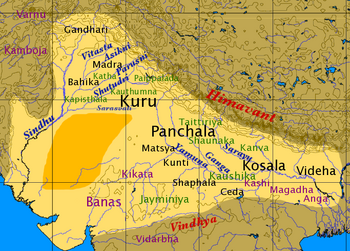Kurujangala

Kurujangala (कुरुजाङ्गल) was kingdom of the Mahabharata period ruled by the Pandava king, Yudhisthira. It was located between the Saraswati and Yamuna rivers, and forms the majority of what is now the modern state of Haryana. Indraprastha, now Delhi, was its capital.
Location
In the epic times (final centuries BC), the region between the triangle of Thaneshwar, Hissar and Hastinapur was distinguished by three different names:
- (1) Kuru-Jangala equal to Rohtak, Hansi, Hissar
- (2) Kuru-rashtra proper between the Ganga and Yamuna with its capital at Hastinapura and
- (3) the Kuru-kshetra comprising Thaneshwar, Kaithal and Karnal.
Mention by Panini
Kurujangala (कुरुजांगल) is mentioned by Panini in Ashtadhyayi. [1]
History
V. S. Agrawala[2] writes that Ashtadhyayi of Panini mentions janapada Kuru (कुरु) (IV.1.172) - It was known to Panini as a janapada and a Kingdom. Hastinapura (VI.2.101) was its capital. The region between triangle of Thanesar, Hisar and Hastinapur was known by three different names. Kururashtra proper between Ganga River and Yamuna with its capital Hastinapur; Kurujangala equal to Rohtak, Hansi, Hisar; and Kurukshetra to the north with its centres at Thaneswar, Kaithal, Karnal.
This was the western part of Kuru. It was filled with forests like Khandava (eastern Hariyana), Rohitaka (Rohtak) and numerous other bush-lands. King Dhritarashtra gave this land to Yudhisthira to end the rivalry between the Pandavas and Kauravas. Yudhisthira developed the waste-land into a prosperous country to the envy of the Kauravas. His brother Arjuna, with the aid of Krishna, cleared the Khandava Forest, after the destruction and re-habitation of the settlements of Nagas, Danavas and Rakshasas who dwelled in those regions. Mayasura was the chief architect of the constructions of the new kingdom, such as the royal court of Yudhisthira at Indraprastha.
In Mahabharata
Adi Parva, Mahabharata/Mahabharata Book I Chapter 94 tells us the History of Puru and of the Pandavas.
- "Samvarana begat upon his wife, Tapati, the daughter of Surya, a son named Kuru. This Kuru was exceedingly virtuous, and therefore, he was installed on the throne by his people. It is after his name that the field called Kuru Jangala has become so famous in the world."
- ततः संवरणात सौरी सुषुवे तपती कुरुम
- राजत्वे तं परजाः सर्वा धर्मज्ञ इति वव्रिरे Mahabharata (1.94.42)
- तस्य नाम्नाभिविख्यातं पृथिव्यां कुरुजाङ्गलम
- कुरुक्षेत्रं स तपसा पुण्यं चक्रे महातपाः Mahabharata (1.94.43)
Udyoga Parva/Mahabharata Book V Chapter 19 mentions Kings and tribes Who joined Yudhishthira for war:
And for this reason the land of the five rivers, and the whole of the region called Kuru-jangala, and the forest of Rohitaka which was uniformly wild, and Ahichhatra and Kalakuta, and the banks of the Ganga River, and Varana River, and Vatadhana, and the hill tracts on the border of the Yamuna--the whole of this extensive tract--full of abundant corn and wealth, was entirely overspread with the army of the Kauravas.
- ततः पञ्चनथं चैव कृत्स्नं च कुरुजाङ्गलम
- तदा रॊहित कारण्यं मरु भूमिश च केवला (V.19.29)
- अहिच छत्रं कालकूटं गङ्गाकूलं च भारत
- वारणा वाटधानं च यामुनश चैव पर्वतः (V.19.30)
- एष थेशः सुविस्तीर्णः परभूतधनधान्यवान
- बभूव कौरवेयाणां बलेन सुसमाकुलः (V.19.31)
Bhisma Parva, Mahabharata/Book VI Chapter 10 Describes geography and provinces of Bharatavarsha. It mentions Jangalas in shloka 37 along with Madras, Shalvas etc.
- अत ऊर्ध्वं जनपथान निबॊध गथतॊ मम ।
- तत्रेमे कुरुपाञ्चालाः शाल्व माद्रेय जाङ्गलाः ।। Mahabharata (6.10.37)</ref>
Udyoga Parva/Mahabharata Book V Chapter 53 mentions The country of the Kurus, including the region called Jangala as the paternal kingdom of Pandavas. Thou hast, however, obtained the whole earth by those heroes. Won by the strength of their arms, the sons of Pritha made over thee this extensive empire.
- पित्र्यं राज्यं महाराज कुरवस ते स जाङ्गलाः
- अद वीरैर जितां भूमिम अखिलां परत्यपथ्यदाः Mahabharata (5.53.7)
Karna Parva/Mahabharata Book VIII Chapter 30 mentions
- Alas, that (Vahika) maiden of large proportions, dressed in thin blankets, is thinking of me,--her Vahika lover--that is now passing his days in Kurujangala, (VIII.30.19)
- तेषां किलावलिप्तानां निवसन कुरुजाङ्गले
- कश चिथ बाह्लीक मुख्यानां नातिहृष्टमना जगौ Mahabharata (8.30.19)
This clan is named as Jāngala in the Vayu Purana, alongwith Bodhas and Bhadhrakars. [3] Matsya Purana says that the river Indus flowed through the country of Jāngalas. Mahabharata also mentions them. [4]
स्वामी ओमानन्द लिखते हैं
इस प्रदेश का नाम कुरुक्षेत्र अथवा कुरु-जांगल भी रहा है । यह तो जगत्प्रसिद्ध है ही कि कुरुक्षेत्र नाम का धर्मक्षेत्र स्थान भी इसी हरयाणे प्रान्त का एक भाग है जिसे प्राचीन काल में महाराजा कुरु ने यहाँ के जंगल कटवा कर और स्वयं अनेक वर्षों तक अपने हाथों से हल चलाकर कृषि के योग्य बनाया था । जिसका इतिहास महाभारत में कुरुक्षेत्र के प्रकरण में विस्तार से दिया है । इसी प्रकार कुरु की सन्तान युधिष्ठिर, अर्जुनादि पाँचों भाइयों ने योगीराज श्रीकृष्ण की आज्ञानुसार भारी जंगल को जलाकर (जो खांडव दाह नाम से प्रसिद्ध है) और असुरों का हनन करके इन्द्रप्रस्थ नाम का नगर बसाया था (जो कि उनकी राजधानी उनके कई वंशों तक रही) । उसी स्थान पर दिल्ली नगर तथा नई दिल्ली आज बसी हुई हैं । कुरु और कुरु की सन्तान ने यहां के जंगलों को उजाड़ कर अपनी बस्ती बसाई और इनकी अनेक पीढ़ियाँ इसके कुछ भाग पर राज्य करती रहीं । इसी कारण इस प्रदेश का नाम कुरु-प्रदेश अथवा कुरु-जांगल है । [5]
See also
References
- ↑ V. S. Agrawala: India as Known to Panini, 1953, p. 54
- ↑ V. S. Agrawala: India as Known to Panini, 1953, p.54
- ↑ XLV, 109, 110
- ↑ Bhim Singh Dahiya, Jats the Ancient Rulers ( A clan study), 1980, Sterling Publishers New Delhi , p. 282
- ↑ Veerbhoomi Haryana/हरयाणा के प्राचीन नाम व स्थान
Back to Ancient Kingdoms

